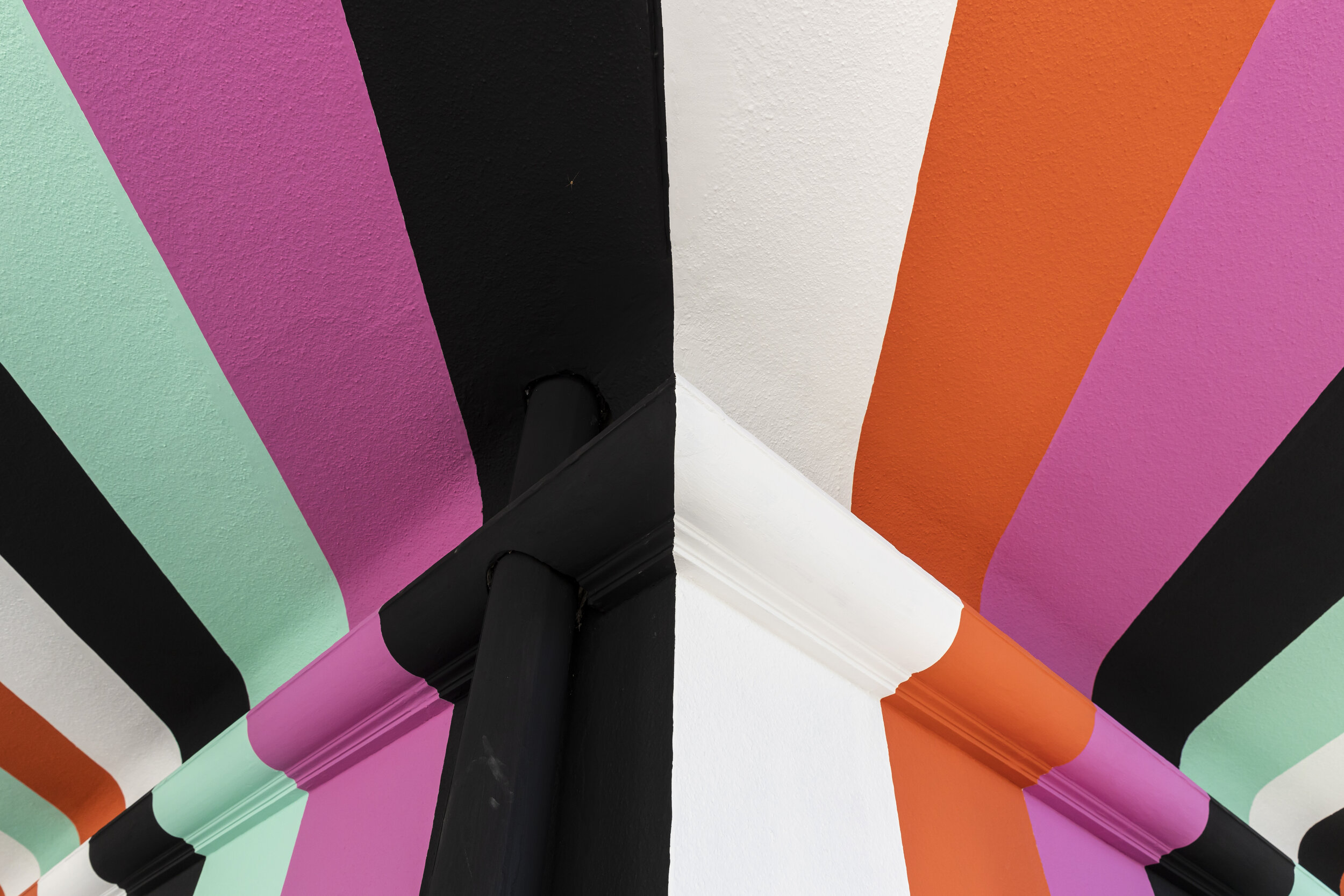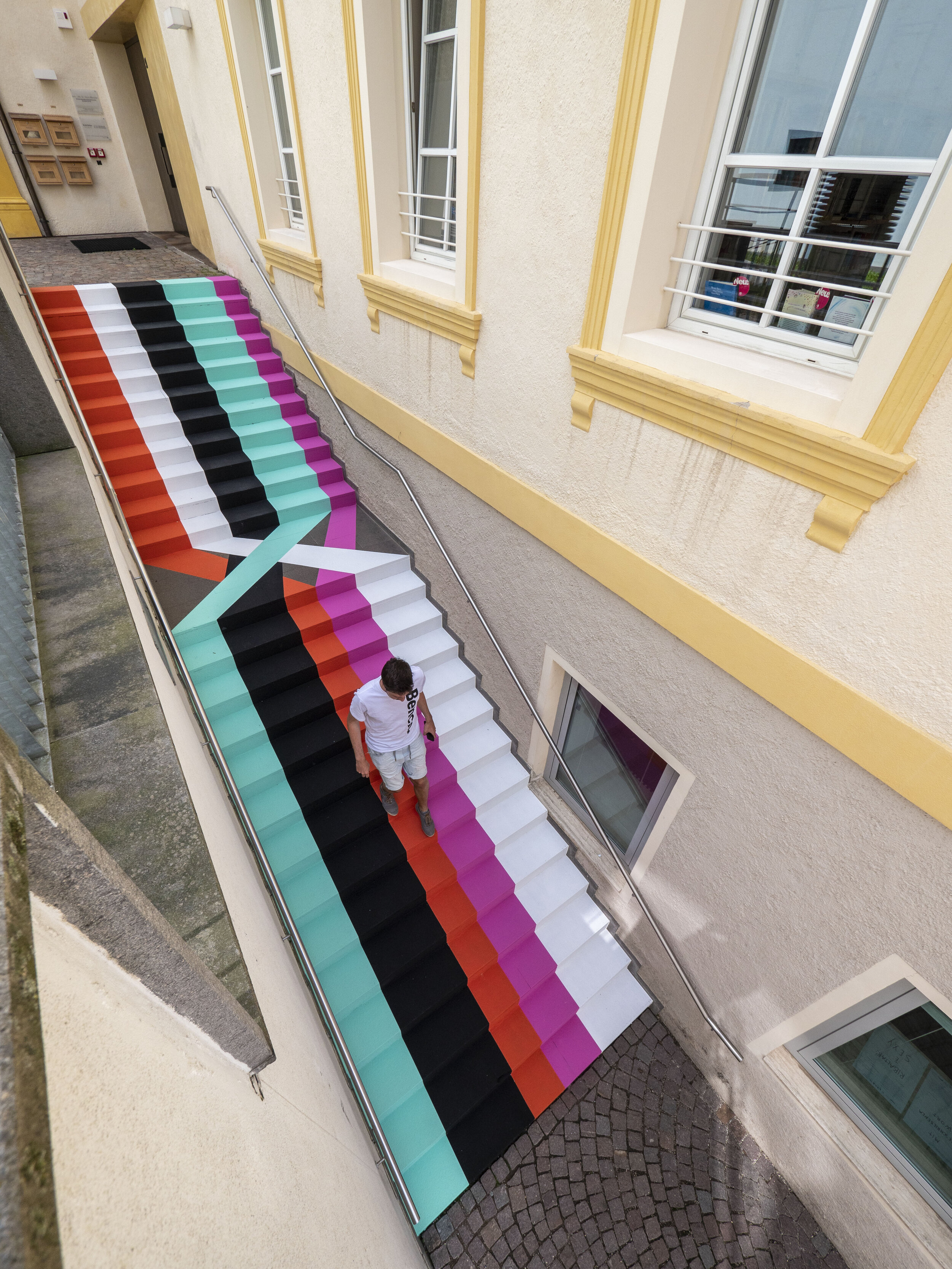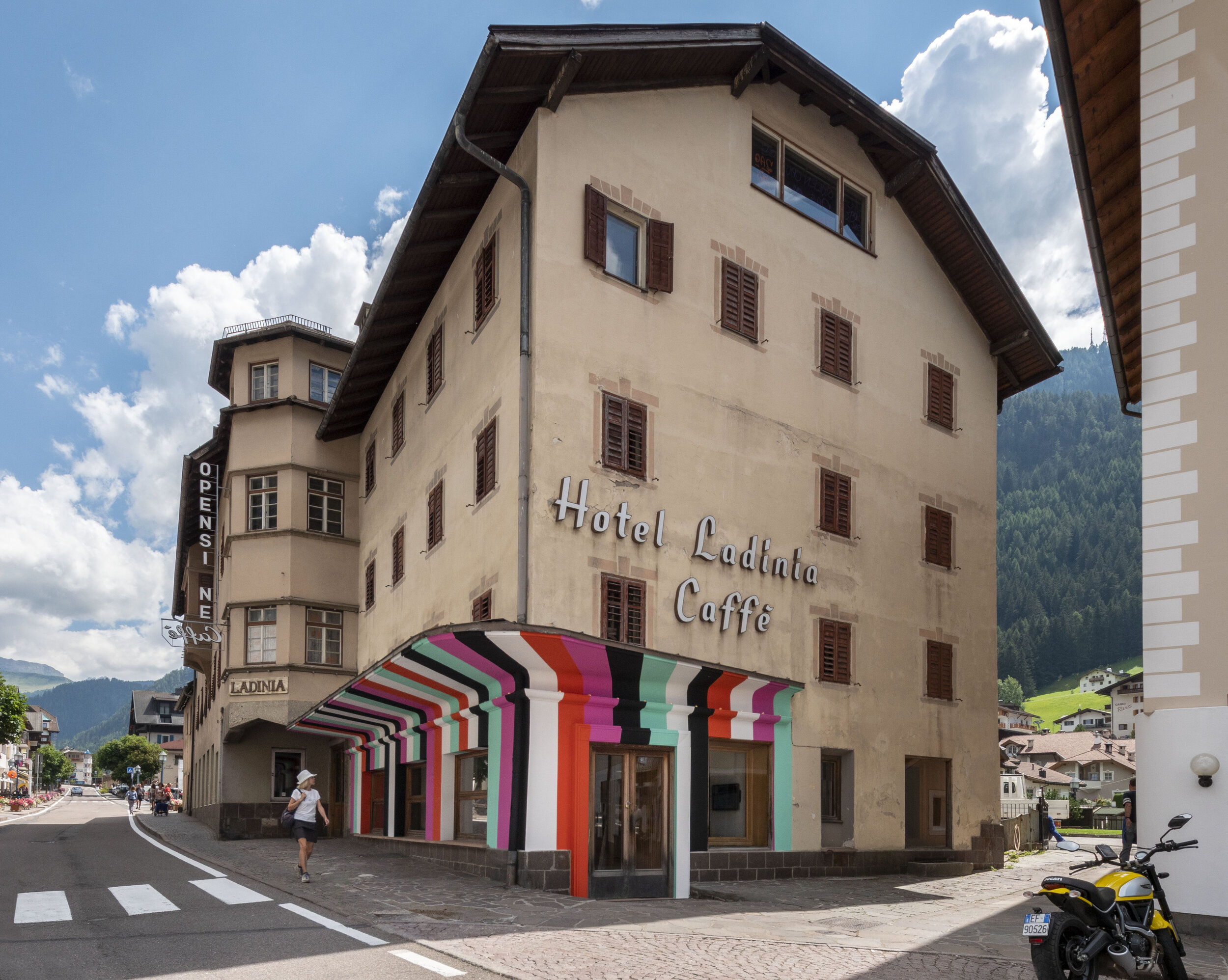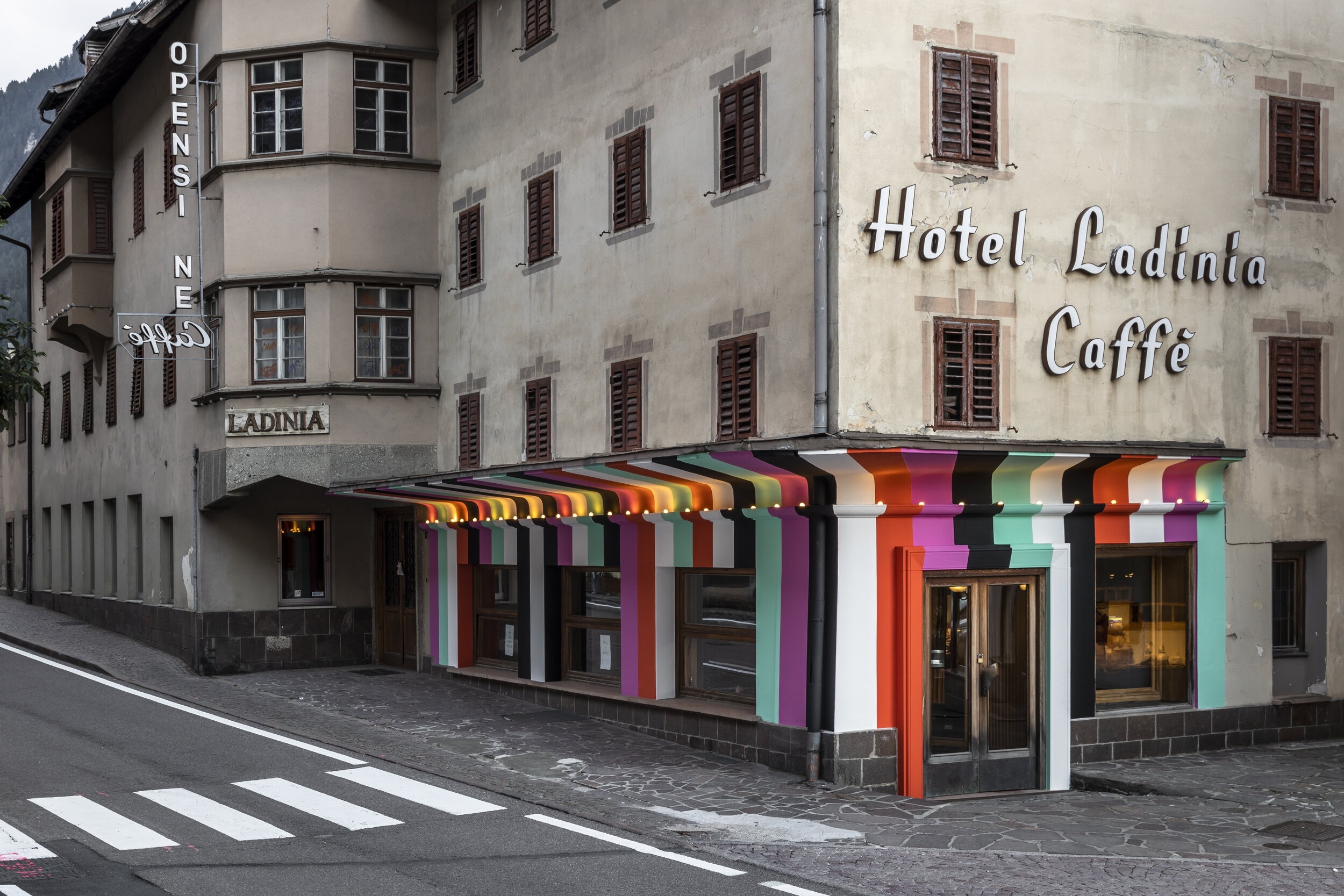
Lang/Baumann
*1972 Switzerland / *1967, USA
both live and work in Burgdorf, Switzerland
EN
Sabina Lang and Daniel Baumann (*1972 Switzerland/*1967, USA) are a Swiss artist duo who have worked together since 1990 under the name Lang/Baumann. Their body of work includes installations, sculptures, large-scale wall or floor paintings, and architectural interventions.
The two artists work with a wide range of material, wood, metal, paint, carpet and inflatable structures, but their true medium is space. Most of their works are site-specific, some are modular and can be adapted to different situations. Many of their objects can not only be viewed but actually used as well, while others merely feign usability or artfully subvert it. Through careful prior analysis of the location and context of their interventions, Lang/Baumann initiate a dialogue with the existing situation, often playfully upending expectations and disrupting patterns of perception. With their opulent imagery, they deliberately seek a delicate balance between clearly defined categories like public and private space, familiar and strange, art and functionality.
The Biennale Gherdëina 7 commissioned two outdoor works by Lang/ Baumann, that mark the beginning and the end of the parcour at the heart of St. Ulrich/ Ortisei: “Beautiful Steps #17”, next to the entrance of Sala Trenker, and “Beautiful Entrance #8”, on the façade and entrance of the Hotel Ladinia. For “Beautiful Steps #17”, the steps of a connecting stairway in the village centre were painted with a motif comprising five stripes of differing width. The stripes in luminous red, magenta and turquoise, as well as black and white run parallel across the straight stairway. At the centre, on the half-landing, about 1.2 metres deep, the stripes change direction and intersect, to then continue running parallel again across the steps in a new succession of colours.
“Beautiful Entrance #8”, on the other hand, was created for the bar on the ground floor of the Hotel Ladinia, close to Antoniusplatz, which has been standing vacant for years. This bar area and has a canopy that surrounds the façade and corner of the building surrounding the bar with a rounded band. For the Biennale Gherdëina 7, the façade below the canopy was painted in black and white and bright vertical stripes. The geometry and width of these strips mirror the door and window openings and blend into the existing architecture. On the underside of the canopy, the stripes continue in fanned-out rays, which are oriented towards the angle of the building corner. In addition, the existing lighting of the canopy was repaired. The building, appearing abandoned and spooky, was given a punctual, but only putative revival through the emphasis and exaggeration of the bar, because on the inside everything continues to stand still.
IT
Sabina Lang e Daniel Baumann (*1972, Svizzera/*1967, USA) sono un duo di artisti svizzeri che lavorano insieme dal 1990 con il nome di Lang/Baumann. La loro ricerca prende la forma di installazioni, sculture, pitture a parete o a pavimento su larga scala e interventi architettonici. I due artisti lavorano con una grande varietà di materiali - legno, metallo, vernice, tappeti, strutture gonfiabili - ma il loro vero strumento è lo spazio: la maggior parte delle opere sono site-specific, alcune sono modulari e possono essere adattate a diverse situazioni. Molte delle opere possono essere sia osservate che fruite; altre si limitano a fingere di essere fruibili o invitano a sovvertirne l’utilizzo. Analizzando attentamente il luogo e il contesto dei loro interventi in una fase preliminare, gli artisti entrano in dialogo con quello che hanno di fronte. Lang/Baumann si interrogano, spesso in modo giocoso, su norme e schemi di percezione comuni e con il loro ricco immaginario cercano un equilibrio tra categorie ben definite: lo spazio pubblico e privato, il familiare e l’insolito, l’arte e la funzionalità. La Biennale Gherdëina 7 ha commissionato a Lang/Baumann due opere all’aperto che segnano l’inizio e la fine del percorso scultoreo all’aperto nel centro di Ortisei, a partire da “Beautiful Steps #17” accanto all’ingresso di Sala Trenker e concludendo con “Beautiful Entrance #8” sulla facciata e all’ingresso dell’Hotel Ladinia.
Per “Beautiful Steps #17” sono stati dipinti i gradini di una scala nel centro del paese con un motivo di cinque strisce di diverse larghezze. Queste corrono parallele in rosso vivo, magenta, turchese, bianco e nero attraverso la scala dritta. Al centro, sul passaggio intermedio profondo circa 1,2 m, le strisce cambiano direzione, si incrociano e poi continuano parallele attraverso i passi in una nuova sequenza di colori.
“Beautiful Entrance #8” invece è stato realizzato vicino a Piazza S. Antonio per il bar al piano terra dell’Hotel Ladinia, in disuso ormai da anni, che ha una tettoia leggermente bombata che percorre la facciata e proseguendo lungo l’angolo dell’edificio. La parte di facciata sotto la tettoia è stata dipinta con vivaci strisce colorate verticali. Adattandosi all’architettura dello spazio, le strisce seguono la geometria e la larghezza delle porte e delle finestre dell’hotel. Sul lato inferiore della terrazza, le strisce proseguono radialmente seguendo l’angolo dell’edificio. Inoltre, è stata ripristinata l’illuminazione sotto la tettoia. Riportando alla luce il bar, l’edificio dall’aspetto spettrale si risveglia solo apparentemente: il bar sembra essere in funzione; all’interno, tuttavia, tutto è ancora fermo.
DE
Sabina Lang und Daniel Baumann (*1972, Schweiz/*1967, USA) sind ein Schweizer Künstlerduo, das seit 1990 unter dem Namen Lang/Baumann zusammenarbeitet. Ihr Werk umfasst Installation, Skulptur, großflächige Wand- oder Bodenmalerei und architektonische Intervention.
Die beiden Künstler arbeiten mit den verschiedensten Materialien – Holz, Metall, Farbe, Teppich, aufblasbare Strukturen –, ihr eigentliches Medium jedoch ist der Raum: Die meisten Arbeiten sind ortsspezifisch, einige sind modular angelegt und können so unterschiedlichen Situationen angepasst werden. Zahlreiche der Werke können nicht nur betrachtet, sondern auch benutzt werden; andere täuschen eine Benutzbarkeit nur vor oder sabotieren sie auf listige Weise. Indem sie Ort und Kontext ihrer Interventionen jeweils vorgängig genau analysieren, treten die Künstler in einen Dialog mit dem Vorgefunden. Lang/Baumann hinterfragen, häufig auf spielerische Art, gängige Normen und Wahrnehmungsmuster und begeben sich mit ihrer opulenten Bildsprache bewusst auf eine Gratwanderung zwischen klar definierten Bereichen – öffentlichem und privatem Raum, Ertrautem und Ungewohntem, Kunst und Funktionalität.
Die Biennale Gherdëina 7 beauftrage Lang/Baumann mit zwei Außenarbeiten, die den Beginn und das Ende des Parcours im Zentrum von St. Ulrich markieren: „Beautiful Steps #17“ neben dem Eingang des Trenker Saales, und „Beautiful Entrance #8” an der Fassade und im Eingangsbereich des ehemaligen Hotel Ladinia.
Bei „Beautiful Steps #17” wurden die Stufen einer Verbindungstreppe im Zentrum des Dorfes mit einem Motiv aus fünf unterschiedlich breiten Streifen bemalt. Diese verlaufen parallel in leuchtendem Rot, Magenta, Türkis sowie Schwarz und Weiß über die gerade Treppe. In der Mitte, auf dem etwa 1,2 Meter tiefen Zwischenpodest, wechseln die Streifen die Richtung, kreuzen sich, um anschließend in neuer Farbfolge wieder parallel über die Stufen weiterzulaufen.
Der „Beautiful Entrance #8” wurde stattdessen in der Nähe des Antoniusplatzes für die Bar im Erdgeschoss des seit Jahren stillgelegten Hotel Ladinia realisiert. Dieser Barbereich ist durch ein leicht abgerundetes Vordach charakterisiert, das entlang der Fassade und an der Ecke des Gebäudes verläuft. Für die Biennale Gherdëina 7 wurde die unterhalb des Vordachs liegende Fassade in schwarz-weißen und farbig leuchtenden vertikalen Streifen bemalt. Diese orientieren sich in Geometrie und Breite an den Tür- und Fensteröffnungen und fügen sich in die vorhandene Architektur ein. An der Unterseite des Vordaches verlaufen die Streifen in aufgefächerten Strahlen weiter, die sich am Winkel der Gebäudeecke orientieren. Zusätzlich wurde die bestehende Beleuchtung des Vordachs wieder in Instand gesetzt. Das geisterhaft verlassen wirkende Gebäude erhielt durch die Betonung und Überzeichnung der Bar eine punktuelle, aber nur vermeintliche Wiederbelebung, denn im Innern steht nach wie vor alles still.




